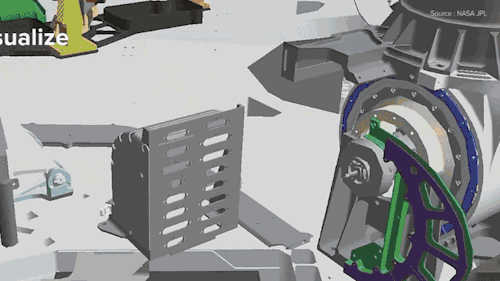The Five W’s Of An Expandable Habitat In Space
The Five W’s of an Expandable Habitat in Space
Who: In this case, it’s really a “what.” The Bigelow Expandable Activity Module (BEAM) is an expandable module developed by Bigelow Aerospace using a NASA patent conceptualized in the 1990s. It is made up of layers of fabric that will expand when installed and equalize with the pressure of the International Space Station.

What: Sensors inside BEAM will monitor temperature and radiation changes, as well as its resistance to potential orbital debris impacts. During its time on station, the airlock between BEAM and the rest of the space station will remained closed, and astronauts will enter only to collect data and help the experiment progress. If BEAM is punctured, the habitat is designed to slowly compress to keep the rest of the space station safe.
With the BEAM launch, deployment and time on station, Bigelow will demonstrate a number of expandable habitat capabilities, such as its folding and packing techniques, radiation protection capability and its thermal, structural and mechanical durability.

When: BEAM is set to launch on SpaceX’s eighth Dragon resupply mission April 8, and will be docked to the space station for a minimum two-year demonstration period.
Where: The International Space Station’s mechanical arm will transport BEAM from the spacecraft to a berthing port on the Tranquility module where it will then be expanded.

Why: These expandable modules take up less room on a rocket, but once set up, provide more volume for living and working in space.

When we’re traveling to Mars or beyond, astronauts need habitats that are both durable and easy to transport and to set up. That’s where expandable technology comes in. BEAM is one of the first steps to test expandable structures as a viable alternative to traditional space habitats.
Make sure to follow us on Tumblr for your regular dose of space: http://nasa.tumblr.com
More Posts from Maevetheeuropan and Others

so this happened

Lockheed Martin joins the space race to Mars
From China to NASA to Elon Musk, it seems everyone has their sights set on Mars exploration. But before we land on the Red Planet, we’ll probably orbit it. At this week’s Humans to Mars summit, Lockheed Martin unveiled its Mars Base Camp concept — an ambitious plan to send a manned space laboratory to orbit Mars by 2028.

Mars used to be much more Earth-like than we once thought. The Curiosity rover recently discovered high levels of manganese oxide, which can only exist in oxygen-rich environments. This means Mars used to have as much oxygen as Earth and plenty of water on its surface. Source Source 2

That looks pretty damn cool.
(via The World’s First ‘Marschitect’ Is Laying the Groundwork for Architecture in Space — How We Get To Next)
Space Station Research: Air and Space Science
Each month, we highlight a different research topic on the International Space Station. In June, our focus is Air and Space Science.

How is the space station being used to study space? Studies in fundamental physics address space, time, energy and the building blocks of matter. Recent astronomical observation and cosmological models strongly suggest that dark matter and dark energy, which are entities not directly observed and completely understood, dominate these interactions at the largest scales.

The space station provides a modern and well-equipped orbiting laboratory for a set of fundamental physics experiments with regimes and precision not achievable on the ground.
For example, the CALorimetric Electron Telescope (CALET) is an astrophysics mission that searches for signatures of dark matter (pictured above). It can observe discrete sources of high energy particle acceleration in our local region of the galaxy.
How is the space station contributing to aeronautics? It provides a long-duration spaceflight environment for conducting microgravity physical science research. This environment greatly reduces buoyancy-driven convection and sedimentation in fluids. By eliminating gravity, space station allows scientists to advance our knowledge in fluid physics and materials science that could lead to better designated air and space engines; stronger, lighter alloys; and combustion processes that can lead to more energy-efficient systems.

How is the space station used to study air? The Cloud-Aerosol Transport System (CATS) is a laster remote-sensing instrument, or lidar, that measures clouds and tiny aerosol particles in the atmosphere such as pollution, mineral dust and smoke. These atmospheric components play a critical part in understanding how human activities such as fossil fuel burning contribute to climate change.

The ISS-RapidScat is an instrument that monitors winds for climate research, weather predictions and hurricane monitoring from the International Space Station.

For more information on space station research, follow @ISS_Research on Twitter!
Make sure to follow us on Tumblr for your regular dose of space: http://nasa.tumblr.com

NASA is building the next Mars rover in mixed reality and It’s absolutely jaw-dropping!

The Exoplanetary Menagerie
Today a massive discovery was announced: 39 light years away in the TRAPPIST-1 star system seven terrestrial planets all orbit extremely close to each other.
…and three are well within their star’s “habitable zone”.
TRAPPIST-1 is an ultra-cool dwarf star. Because its temperature is so much lower than a typical star like the sun (it’s roughly 2550 K while the sun’s 5772 K) planets are able to orbit much closer than they could in our Solar System and sustain habitable conditions. All seven of the discovered exoplanets orbit closer to TRAPPIST-1 than Mercury does to the sun.
Of the different planets discovered, one is immensely Earthlike, having a similar size and receiving roughly the same amount of light as Earth. This place could be a whole lot more like home than anything we’ve found yet. Another planet is a potential water-world, getting about as much light as does Mars (with an atmosphere, yes, it could be a liquid water world).
So close do these planets all orbit near to each other that if you were to go to one and look up, you could see the other planets in the sky above you… and they’d be as big as *or larger than the Moon is in our sky*. It must be one of the most beautiful sights.
So what’s the big deal right? NASA’s already found over 3000 exoplanets - what makes these ones special?
A few remarkable things:
One, TRAPPIST-1 is a member of the M-class stars - stars which make up 70% or so of all the stars out in the Milky Way. Knowing that such stars can host magnificent habitable planetary systems means the search for life just got blown wide open to 70% of the stars in our galaxy.
Two, though 39 light years seems far, this is actually unimaginably close. We’re basically neighbors. The fact that TRAPPIST-1 is so close means that astronomers will be able to subject this place to decades of intense research.
As NASA begins to turn space telescopes such as Hubble, Kepler and Spitzer on TRAPPIST-1, I think we’ll be hearing a lot more from it soon.
Before you go, please consider joining the Planetary Society. If TRAPPIST-1 intrigues you, just wait until you see what else we have happening.
At the Planetary Society we have a radio show with some of the most groundbreaking material to include exoplanet hunters, engineers designing interstellar missions and interviews with astronauts. Most important though, we go to D.C. and make sure the politicians continue funding NASA and space science, and we reach out to people and try to show them what could be.
On that note, here are some artist conceptions of the TRAPPIST-1 star system and what could be:





So good job to the team that made this discovery (especially lead author Michaël Gillon) and I can’t wait to learn more about this place soon.
(Image credit: NASA-JPL/Caltech, NASA/JPL-Caltech/R. Hurt (IPAC), NASA/JPL-Caltech/T. Pyle (IPAC), NASA/JPL-Caltech/R. Hurt (IPAC), ESO/M. Kornmesser and NASA-JPL/Caltech respectively)
-
 bleakevgere liked this · 1 year ago
bleakevgere liked this · 1 year ago -
 gorandiro liked this · 3 years ago
gorandiro liked this · 3 years ago -
 darthkyros reblogged this · 3 years ago
darthkyros reblogged this · 3 years ago -
 newengland-sourdoh reblogged this · 7 years ago
newengland-sourdoh reblogged this · 7 years ago -
 acceptableinthe1980s reblogged this · 7 years ago
acceptableinthe1980s reblogged this · 7 years ago -
 agentpoptart liked this · 7 years ago
agentpoptart liked this · 7 years ago -
 rainy-morning-wood liked this · 7 years ago
rainy-morning-wood liked this · 7 years ago -
 redactedbun liked this · 7 years ago
redactedbun liked this · 7 years ago -
 fidanzatti-blog liked this · 7 years ago
fidanzatti-blog liked this · 7 years ago -
 fredrick-smith liked this · 7 years ago
fredrick-smith liked this · 7 years ago -
 blackcatcircles liked this · 7 years ago
blackcatcircles liked this · 7 years ago -
 josephs-alyssa44u1x5l liked this · 7 years ago
josephs-alyssa44u1x5l liked this · 7 years ago -
 charlottephillips-blog1 liked this · 8 years ago
charlottephillips-blog1 liked this · 8 years ago -
 nickcitrus liked this · 8 years ago
nickcitrus liked this · 8 years ago -
 pagetboobstarcomments liked this · 8 years ago
pagetboobstarcomments liked this · 8 years ago -
 mariachi-screamo-opera-blog liked this · 8 years ago
mariachi-screamo-opera-blog liked this · 8 years ago -
 maevetheeuropan reblogged this · 8 years ago
maevetheeuropan reblogged this · 8 years ago -
 prv-d-maliline reblogged this · 8 years ago
prv-d-maliline reblogged this · 8 years ago








